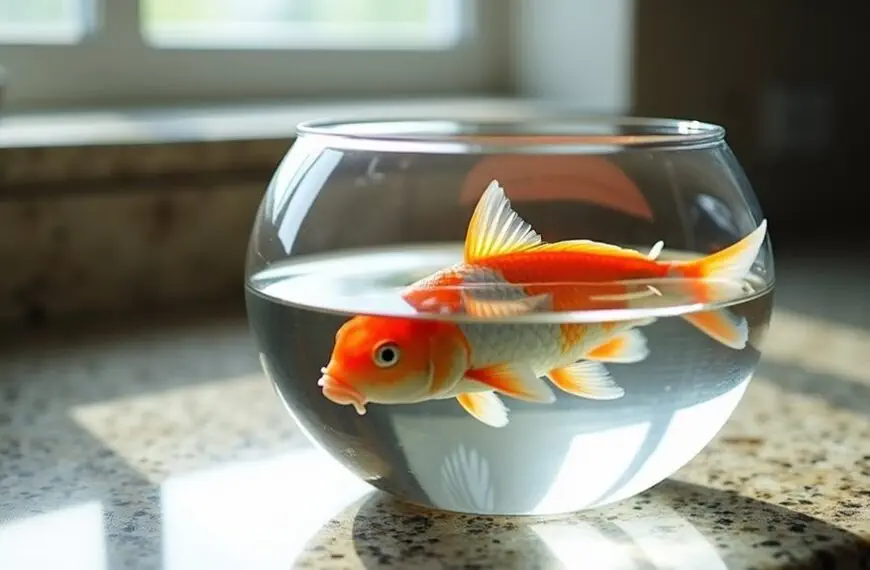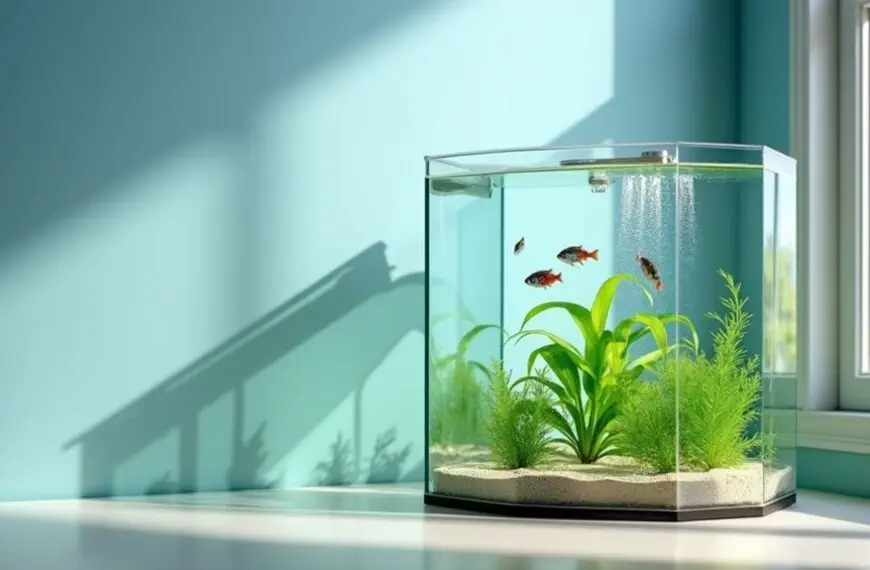When starting your first aquarium, you'll want to choose hardy fish that can handle the cycling process. Danios and Barbs make excellent first fish choices since they're tough and adaptable to changing water conditions. Start with just 2-3 small fish, giving them about 1-2 gallons of water per inch of their adult length. Before adding any fish, make sure your tank has been cycling for 24-48 hours with proper filtration and heating. You'll also need to monitor ammonia and nitrite levels daily during the first few weeks. The success of your aquarium journey depends on these critical first steps.
Contents
- 1 Understanding New Tank Syndrome
- 2 Best Hardy Fish Species
- 3 Preparing Your Tank First
- 4 Proper Fish Acclimatization Steps
- 5 Starting With School Fish
- 6 Tank Size Requirements
- 7 Water Parameters For Beginners
- 8 Common First Fish Mistakes
- 9 Fish Compatibility Guidelines
- 10 Maintaining Your First Fish
- 11 Frequently Asked Questions
- 11.1 How Long Should I Quarantine New Fish Before Adding Them?
- 11.2 Can I Add Fish Immediately After Using Water Conditioner?
- 11.3 Should I Feed My First Fish Immediately After Introducing Them?
- 11.4 What Is the Best Time of Day to Introduce New Fish?
- 11.5 Can I Mix Different Brands of Fish Food for Beginners?
- 12 Final Thoughts
Understanding New Tank Syndrome
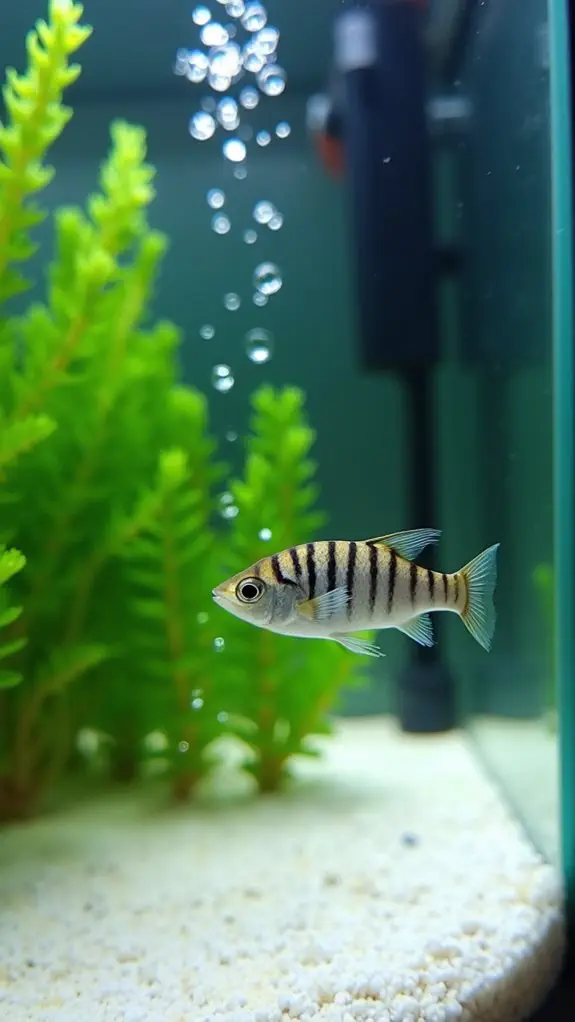
Three critical factors contribute to New Tank Syndrome: toxic compound buildup, an immature nitrogen cycle, and insufficient beneficial bacteria.
When you're starting your new tank maintenance journey, these invisible troublemakers can quickly turn your aquatic dreams into a challenging situation. Full establishment of healthy bacteria colonies typically takes up to 2 months. During this time, it's vital to monitor ammonia levels closely to ensure a healthy environment for your future fish.
You'll notice the first signs when your water turns cloudy, and your fish start acting sluggish. It's like they're swimming in a toxic soup that's getting worse by the day.
The problem starts because your tank's filter doesn't have enough beneficial bacteria to handle all the waste your fish produce. Think of it as having a cleaning crew that's seriously understaffed! Testing shows that nitrite levels rise dramatically during this critical period.
To avoid this common newcomer's headache, you'll need to introduce fish gradually and feed them sparingly.
Regular water changes are your best friend during this period, and using filter assistance products can help jump-start your bacterial colony.
If you're seeing your fish gasping at the surface or noticing algae taking over your tank, don't panic – these are typical symptoms that you can address with proper care and patience. With proper cycling, you can establish a healthy environment that helps prevent these problems from arising.
Best Hardy Fish Species
When you're ready to stock your new aquarium, you can't go wrong with Danios and Barbs as your first fish, since they're known for their remarkable hardiness and adaptability. Tiger Barbs, in particular, will bring plenty of energy and personality to your tank, though you'll want to keep them in groups of at least six to prevent any bullying behavior. For best results in preventing aggressive behavior, Tiger Barbs should be housed with other larger barbs. These peaceful community fish make excellent tank mates since they are part of the hardy Cypriniforms family. Additionally, their ability to thrive in a range of stable water conditions makes them an ideal choice for novice aquarists.
These active swimmers aren't just tough – they're also fascinating to watch as they zip around your aquarium, making them perfect candidates for beginners who want both durability and entertainment value.
Danios as Starter Fish
Looking for the perfect starter fish? Danios might be your ideal aquatic companions! These lively little swimmers are known for their hardy nature and adaptability, making them excellent choices for beginners. You'll love watching their Danio behavior as they zip around your tank in playful schools, bringing instant energy to your aquarium.
These members of the Cyprinidae family are incredibly forgiving when it comes to water conditions, and they'll happily thrive in both heated and unheated setups. Most species prefer water temperatures 70-78°F. Starting with 2-3 fish is recommended when first establishing your tank. Additionally, ensuring optimal pH levels can enhance their well-being and overall health.
You've got several beginner-friendly options to choose from, including the popular Zebra Danio, the elegant Pearl Danio, and the striking Glowlight Danio. They're not picky eaters either – they'll enthusiastically accept whatever fish food you offer!
To keep your danios happy, give them a 10-20 gallon tank with plenty of swimming space and gentle filtration. They're social butterflies, so keep them in groups of at least 3-5 fish.
If you're interested in Danio breeding, you're in luck – they're quick to reproduce when provided with the right conditions and extra food.
Just remember to maintain regular water changes, and these hardy little fish will reward you with years of entertainment!
Barbs for Beginners
Beginner aquarists' search for hardy fish often leads them straight to barbs, nature's perfect starter species. When you're comparing barb species for your first tank setup, you'll find several excellent options that'll make your aquarium journey easier and more enjoyable. Just like 10-gallon tanks work well for swordtails, they're also perfect for most barb species. These beautiful fish showcase their best vibrant colors when kept in well-maintained environments, so it's important to maintain water quality for optimal health.
For the best success with your barb tank setup, consider these top beginner-friendly choices:
- Cherry Barbs – They're peaceful, adaptable, and perfect for community tanks. You'll love watching them school together in open spaces.
- Rosy Barbs – These lively swimmers are incredibly hardy and will thrive in various water conditions, making them ideal for newcomers.
- Golden Barbs – They're bright, cheerful, and get along well with other fish, adding a splash of color to your aquarium.
- Tico Barbs – While they need specific care, they're still suitable for beginners who do their homework.
You'll want to provide plenty of swimming space and hiding spots for your barbs, regardless of which species you choose.
Easy-Care Tiger Barbs
Among all barb species, Tiger Barbs stand out as the powerhouse of hardiness and adaptability. You'll love how these little swimmers can thrive in various water conditions, making them perfect for both new and experienced aquarists. Their bright orange splashes and distinctive black stripes make them visually striking additions to any aquarium. Just remember, Tiger barb behavior can be a bit feisty – they're known for their playful nipping habits! Their natural diet in the wild consists of small crustaceans and insects, contributing to their active hunting behavior.
To keep your Tiger Barbs happy and well-behaved, you'll need to house them in groups of at least eight. This isn't just a random number – it's the magic minimum that helps distribute their natural spunkiness within the school instead of targeting other fish. Studies show that schooling fish experience reduced stress and enhanced wellbeing when kept in adequate numbers.
When considering tiger barb tankmates, you'll want to avoid slow-moving fish with flowing fins, as these can become tempting targets for nipping. These striped beauties aren't picky eaters, which makes feeding time a breeze. They'll enthusiastically accept flakes, pellets, and the occasional treat like frozen bloodworms.
Keep their 20-gallon (or larger) tank well-planted, maintain the temperature between 71-79°F, and you'll have a thriving school of Tigers that can live up to seven years!
Preparing Your Tank First
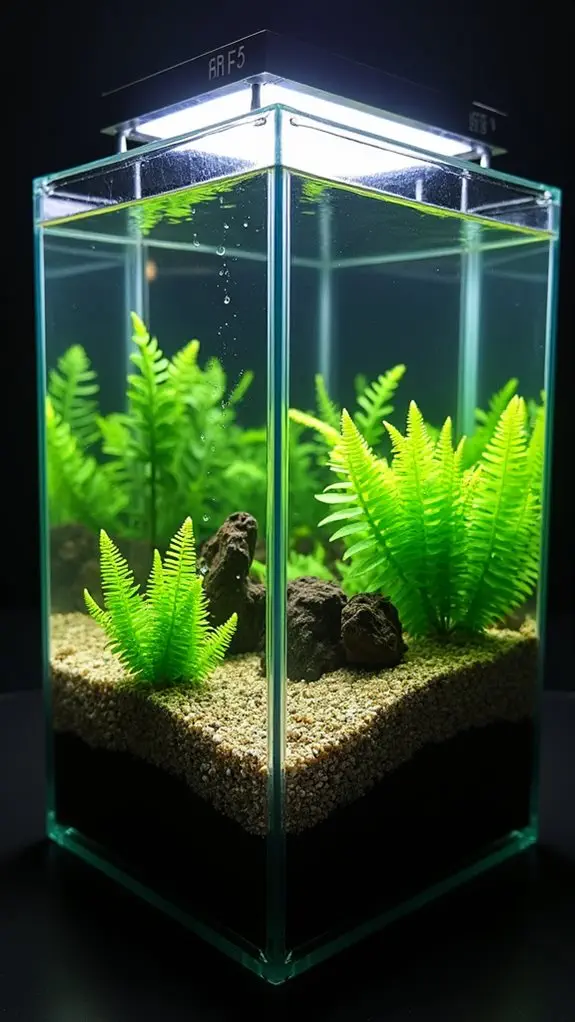
Successfully setting up your first aquarium starts with proper tank preparation.
Before you bring home those beautiful fish you've been eyeing, you'll need to create the perfect underwater environment for them.
Think of it as building a cozy home – you wouldn't move into a house without furniture and utilities, right?
Here's what you'll need to do for proper tank maintenance and equipment setup:
- Start by placing your aquarium on a sturdy stand, making sure it's level and can support the weight of water and decorations.
- Install essential equipment like filters (rated for double your tank's capacity), heaters, and proper lighting.
- Add dechlorinated water and begin the cycling process, which typically takes 24-48 hours to establish beneficial bacteria essential for breaking down waste in the aquarium.
- Test water parameters regularly using a reliable test kit.
Proper Fish Acclimatization Steps
Bringing your first fish home marks an exciting milestone, but proper acclimatization is essential for their survival.
Let's walk through the key acclimation techniques that'll help your new aquatic friend adjust smoothly to their environment.
Start by floating the sealed bag in your tank for about 20-30 minutes to match temperatures.
You'll want to gradually add small amounts of your tank water to the bag, which helps your fish adjust to the pH levels without stress.
Think of it as giving your fish a gentle introduction to their new home, rather than throwing them into the deep end!
Keep an eye out for common fish stressors during this process.
Dim the lights to help them feel secure, and don't rush to feed them right away – they'll need time to explore their surroundings first.
You'll also want to monitor other tank inhabitants to prevent any bullying (fish can be quite territorial!).
Remember to never mix the bag water with your tank water, as this could introduce unwanted guests like parasites.
Instead, use a net to transfer your fish once they're properly acclimated, and you'll be setting them up for success in their new home.
Additionally, it's crucial to ensure that ammonia levels are at 0 ppm to maintain a safe environment before introducing your fish.
Starting With School Fish
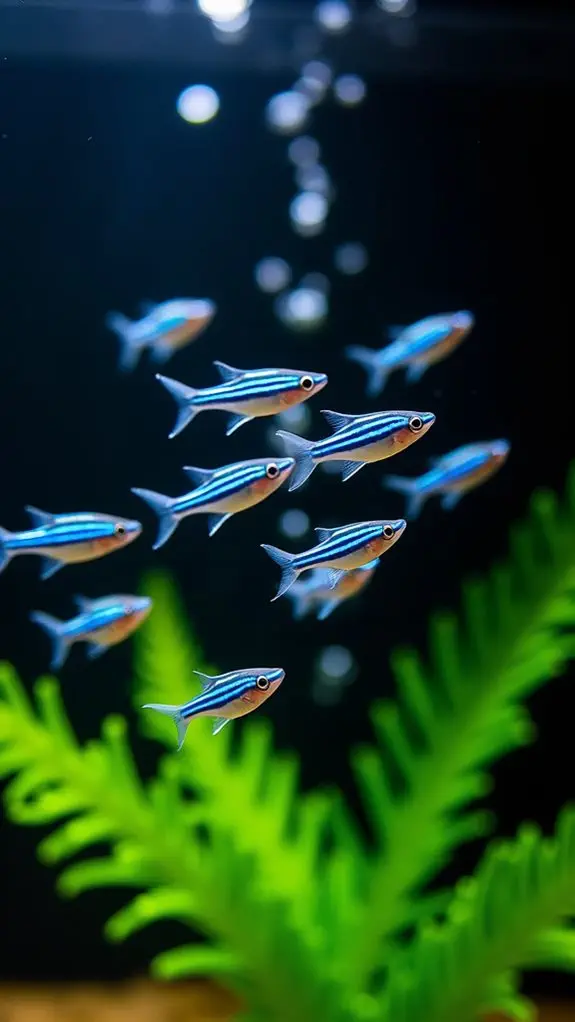
School fish offer a perfect entry point for new aquarists, creating vibrant movement and natural behavior in your tank. When considering beginner fish types, you'll want to focus on hardy species that adapt well to new environments and demonstrate excellent school fish compatibility.
Start your aquarium journey with these proven choices:
- Danios – They're incredibly resilient and will zip around your tank with endless energy.
- Tiger Barbs – These spunky swimmers bring both color and personality to your aquarium.
- Harlequin Rasboras – They're peaceful performers that'll create stunning formations.
- Cherry Barbs – These easy-going fish will make you look like a pro from day one.
Begin with a small group of 3-5 fish from your chosen species, and you can gradually add more as your tank stabilizes. Maintaining stable water parameters is crucial for the health of your fish.
You'll want to avoid common beginners' mistakes like adding tetras or cichlids too early, as they're more sensitive to new tank conditions.
Remember, it's better to start small and succeed than to rush and face setbacks.
Watch your new fish closely in the first few weeks, and you'll be rewarded with a healthy, active school that brings life to your aquarium.
Tank Size Requirements
Your aquarium's size directly affects your fish's health, comfort, and longevity. When planning your fish tank, you'll need to provide 1-2 gallons of water volume for each inch of adult fish length – though there are some exceptions to this rule, like those tiny guppies and tetras you see at the store.
Remember, some fish aren't showing their true potential at the pet store. That cute little oscar or catfish might look manageable now, but they'll grow considerably larger and need much more space than you'd expect. Even goldfish, despite their small size, need larger tanks because they're quite the mess-makers!
Start small with just 2-3 fish in your new tank, even if it's tempting to create an underwater party right away. You'll want to let your tank cycle for a couple of weeks before adding any finned friends, and then gradually introduce more over time. Monitoring water quality is essential for keeping your new fish healthy during this process.
This patient approach helps maintain stable water conditions and keeps your fish healthy. Think of it like moving into a new house – you wouldn't invite the whole neighborhood over on day one, right?
Water Parameters For Beginners
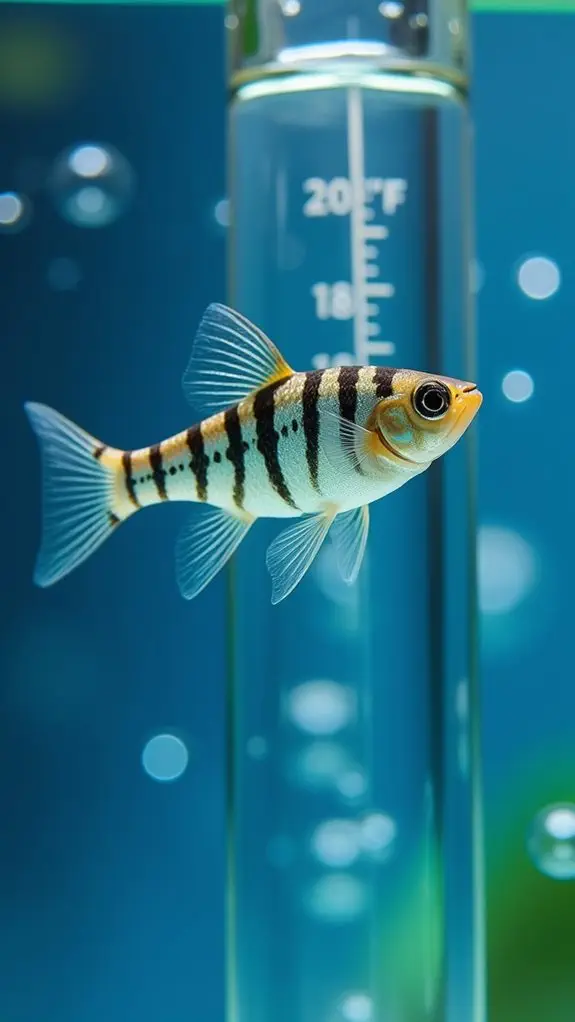
Getting your water parameters right is one of the most essential steps in fishkeeping success.
Before adding any fish to your new aquarium, you'll need to understand and maintain proper water conditions. Regular water testing is vital to guarantee your future fish will thrive in their new home.
Here are the key parameters you'll need to monitor:
- pH levels should stay between 6.5 and 7.5 for most community fish – think of it as creating the perfect "comfort zone" for your aquatic friends.
- Ammonia and nitrite levels must be at 0 ppm (that's zero, zilch, nada!)
- General Hardness (GH) requirements vary by species, but most beginners should aim for 8-12 dGH.
- Carbonate Hardness (KH) helps maintain parameter stability and should be between 4-8 dKH.
Maintaining high water quality is imperative as it directly supports fish health and well-being.
Common First Fish Mistakes
You're probably excited to fill your new tank with fish, but rushing to add multiple species at once is one of the biggest mistakes new aquarists make.
When you haven't researched your fish's needs or temperaments, you might end up with incompatible tankmates that'll make your aquarium feel more like an underwater fight club than a peaceful habitat.
Taking time to properly acclimate each new fish and spacing out your additions will help your underwater friends adjust to their new home without the stress of competing for territory or resources.
Rushing Multiple Fish Additions
The most common mistake new aquarists make is adding too many fish too quickly to their tank. When you're excited about your new aquarium, it's tempting to stock it immediately, but this can seriously disrupt tank stability and natural fish behavior. Your aquarium needs time to establish its nitrogen cycle, and rushing this process can lead to stressed, sick, or dying fish.
Here's what happens when you add too many fish at once:
- The filter system becomes overwhelmed with waste, leading to dangerous ammonia spikes.
- Fish compete aggressively for territory and resources, causing unnecessary stress.
- Diseases spread more easily among stressed fish populations.
- Water parameters fluctuate dramatically, making it harder to maintain balance.
To keep your aquarium healthy, start with just two or three small fish and wait about two weeks before adding more.
You'll want to provide 1-2 gallons of water per inch of adult fish length, so plan your additions carefully. Think of it like introducing new employees to a workplace – everyone needs time to adjust and find their place.
Poor Species Selection Choices
Species selection blunders can quickly turn an exciting new aquarium into a frustrating experience. You'll need to take into account several vital factors before choosing your first fish, and proper species research is essential for success.
Remember that many fish sold in stores are juveniles, and they'll grow much larger than you might expect – that cute little oscar won't stay tiny forever!
When it comes to fish compatibility, you'll want to avoid aggressive species like cichlids, which can turn your peaceful tank into an underwater fight club. Instead, think about starting with gentle schooling fish that get along well with others.
But don't rush to add too many at once, as this can overwhelm your tank's ecosystem.
Be mindful of each species' specific needs. Some fish require special diets or particular water conditions to thrive.
For example, goldfish aren't just easy starter pets – they're cold-water fish that produce lots of waste and need plenty of space.
You'll also want to avoid sensitive species during your tank's startup phase, as they're more likely to struggle with changing water conditions.
Your best bet is to choose hardy fish that can tolerate slight fluctuations while your aquarium stabilizes.
Skipping Acclimation Steps
Many new aquarists make the vital mistake of rushing their fish straight from the store bag into their tanks. This shortcut can lead to severe fish stress and potential health issues that could've been easily avoided with proper acclimation methods.
Your new aquatic friends need time to adjust to their environment gradually, just like you'd need time to adjust to a new home.
Here's what happens when you skip vital acclimation steps:
- Temperature shock can strike immediately, causing your fish to become lethargic or even die from the sudden change.
- Rapid shifts in water parameters like pH and salinity can overwhelm your fish's system.
- Without proper quarantine, diseases can spread quickly to your entire tank.
- Rushing the process creates unnecessary stress that weakens your fish's immune system.
Fish Compatibility Guidelines
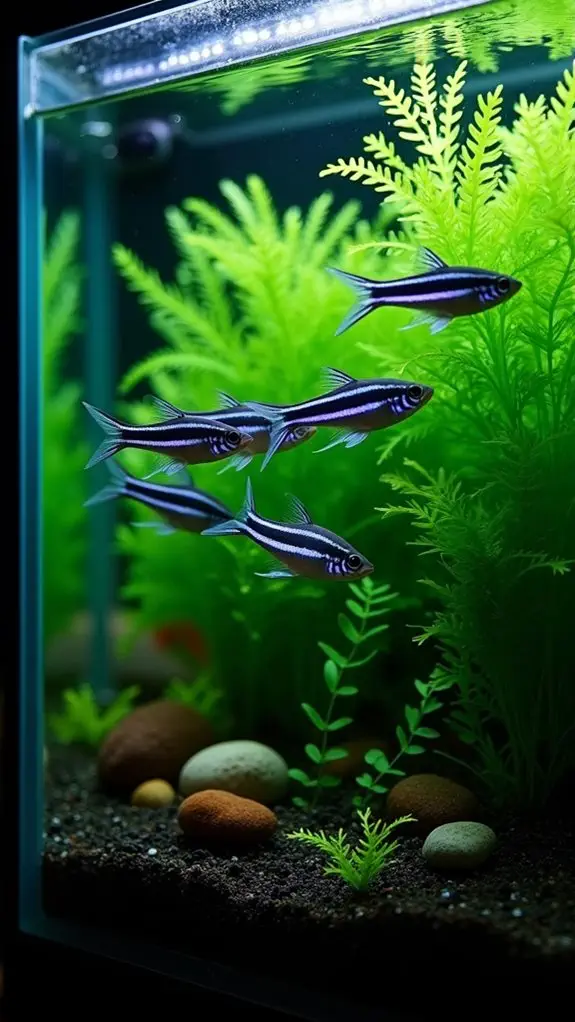
Successful fish-keeping depends heavily on understanding proper compatibility between different species in your aquarium. When you're choosing your first fish, you'll need to take into account their temperament and dietary needs to guarantee they'll get along swimmingly (pun intended!) with future tank mates.
Start by researching fish that share similar water requirements but occupy different swimming levels in your tank. You don't want everyone competing for the same space – that's like having three kids fighting over the front seat!
Add peaceful fish first, giving them time to establish their territories before introducing more assertive species. It's also smart to introduce fish in odd numbers, which helps reduce territorial disputes and makes for a more natural-looking aquarium.
Remember to provide plenty of hiding spots using rocks and plants – think of these as little fish condos where your aquatic friends can retreat when they need some alone time.
Keep an eye on feeding time too, as hungry fish tend to be grumpy fish. If you notice any bullying behavior, you might need to rearrange decorations or, in extreme cases, separate the troublemakers.
Maintaining Your First Fish
You'll want to check your tank's water quality each day to catch any problems early, especially during those first few weeks with your new fish.
It's important to stick to a regular feeding schedule – just a pinch of food two or three times daily is perfect, and you'll soon learn your fish's favorite "dinner time."
Keep an eye out for any unusual behavior or appearance changes, as catching health issues early makes them much easier to treat, and you'll quickly become an expert at spotting when something's not quite right with your finned friends.
Daily Water Quality Checks
Your aquarium's long-term success depends heavily on maintaining proper water quality through daily testing.
During the tank cycling process, you'll need to monitor ammonia and nitrite levels closely using a reliable liquid test kit – don't rely on those less accurate test strips! Think of yourself as your fish's personal water quality detective, always on the lookout for potential problems before they become serious issues.
Here's what you'll need to check daily to keep your finned friends happy:
- Ammonia levels – even the smallest amount can harm your fish
- Nitrite readings – these should always be at zero
- pH levels – stability is key for your specific fish species
- Temperature – consistent warmth keeps stress levels down
You'll want to keep your testing supplies organized and easily accessible, including your water conditioner and gravel vacuum for those necessary water changes.
When you spot any concerning readings, don't panic! Simply perform a partial water change and continue monitoring.
Proper Feeding Schedule
Now that you've mastered water quality testing, establishing a proper feeding schedule stands as the next fundamental skill for fish care. Your fish's health depends heavily on finding the right balance between feeding frequency and portion control, and you'll want to get this right from day one.
Start by researching your specific fish's dietary needs, as each species has unique requirements. You'll need to develop a consistent routine, feeding small amounts at the same times each day.
If you're like most new fish keepers, you might be tempted to shower your finned friend with food, but remember – less is more! Watch how much your fish actually eats within a few minutes, and remove any leftover food to maintain water quality.
To guarantee proper nutritional balance, you'll want to mix up your fish's menu. Think of it as running a tiny underwater restaurant – offer a variety of foods like quality flakes, frozen treats, and perhaps even live food if appropriate for your species.
Creating this dietary variety isn't just about nutrition; it also keeps your fish engaged and active during feeding time.
Disease Prevention Tips
Three critical steps form the foundation of disease prevention in your new aquarium: quarantine, observation, and proper maintenance.
You'll want to catch any disease symptoms early and minimize aquarium stressors to keep your fishy friends healthy and happy.
Here's what you need to focus on to maintain a disease-free tank:
- Set up a separate quarantine tank for new fish and keep them there for 4-6 weeks – it's like a mini fish health spa!
- Monitor water quality religiously through regular testing and water changes.
- Feed high-quality food that supports your fish's immune system.
- Watch for signs of stress, such as rapid breathing or unusual swimming patterns.
Frequently Asked Questions
How Long Should I Quarantine New Fish Before Adding Them?
You'll need to quarantine new fish for 3-4 weeks to guarantee ideal fish health. If you're using preventative medications, you can shorten the quarantine duration to 2 weeks, but longer periods are safer.
Can I Add Fish Immediately After Using Water Conditioner?
While water conditioner effects are quick, you should wait 15-30 minutes before adding fish. During this time, prepare for fish acclimation tips like floating the bag and gradually introducing tank water.
Should I Feed My First Fish Immediately After Introducing Them?
Don't feed your fish immediately after introducing them. Wait at least 24 hours to let them adjust to their new environment. Following proper fish acclimation, you can start a regular feeding schedule gradually.
What Is the Best Time of Day to Introduce New Fish?
You can introduce fish during morning routines or evening preferences – both times work well. Morning gives fish a full day to adjust, while evening's calmer environment reduces stress. Choose what fits your schedule best.
Can I Mix Different Brands of Fish Food for Beginners?
Yes, you can safely mix different brands of fish food types. It's beneficial for providing varied nutrition to your fish. Just maintain consistent feeding schedules and only give what they'll eat in one minute.
Final Thoughts
You're now equipped to make a smart choice for your first aquarium fish! Remember to cycle your tank properly and start with hardy species like danios, tetras, or platies. They'll help you learn the ropes of fishkeeping while being forgiving of minor beginner mistakes. Keep testing your water parameters, follow proper acclimation steps, and don't rush to add too many fish at once. Your patience will pay off with a thriving, healthy aquarium!


